Linux shell编程学习笔记37:readarray命令和mapfile命令
?
目录?
?
0 前言
在交互式编程中,数组元素的值有时是需要从程序外部输入的。比如由用户通过键盘输入的,这时我们可以使用read -a命令来实现,但需要重复输入的数据比较多时,用read -a命令就不太方便,效率也不够高。而且对于有些经常使用的固定数据,我们可以把这些数据存放在一个文件里,然后在使用这些数据的时候,再从文件里把数据读出来。
为此,Linux专门提供了 readarray命令。
?1? readarray命令的格式和功能
我们 可以使用命令 help readarray 来查看?readarray 命令的帮助信息。
purleEndurer @ bash ~ $ help readarray
readarray: readarray [-n count] [-O origin] [-s count] [-t] [-u fd] [-C callback] [-c quantum] [array]
? ? Read lines from a file into an array variable.
? ??
? ? A synonym for `mapfile'.purleEndurer @ bash ~ $ readarray --help
bash: readarray: --: invalid option
readarray: usage: readarray [-n count] [-O origin] [-s count] [-t] [-u fd] [-C callback] [-c quantum] [array]
purleEndurer @ bash ~ $?

?可惜help readarray命令 显示的帮助信息不多。我们 又尝试??readarray --help 命令,但是readarray 命令不支持?--help 选项。
1.1 命令格式
readarray [-n 最大行数] [-O 起始下标] [-s 跳过行数] [-t] [u 文件描述符] [-C 回调程序] [-c 行数] [数组名]
| 选项 | 说明 | 备注 |
|---|---|---|
| -c 行数 | 每读取指定行数就调用一次"-C 回调程序"选项指定的回调程序 默认为每5000行调用一次回调程序 | count |
| -C 回调程序 | 每读取"-c 行数"选项指定的行数就执行一次回调程序 | callback |
| -n 最大行数 | 最多只拷贝指定的最大行数的数据到数组中 默认为0,即拷贝所有行。 | number |
| -O 起始下标 | 指定从哪个下标开始存储数据,默认为0。 对于二维数组来说,指定的是起始行数。 | origin |
| -s 跳过行数 | 忽略指定的跳过行数中的数据,从跳过行数之后开始 | skip |
| -t | 移除尾随行分隔符,默认是换行符 主要配合 -u选项使用 | trim |
| -u 文件描述符 | 指定从文件描述符而非标准输入中读取数据 | use |
1.2?命令功能
从标准输入或指定文件读取数据并存储到指定的数组中。
1.3?注意事项
- 在标准输入数据时,按Enter键换行,输完所有数据后,要按Ctrl+D来结束输入(Ctrl+D在屏幕上无显示)。
- 如果指定的数组变量原来已储存有数值,在使用readarray命令时没有-O选项,那么数组变量中原有的数据会先被清空,然后再存储新读取的数据。
- 如果不指定数组名,则数据会保存到MAPFILE数组中。
2?命令应用实例
2.1 从标准输入读取数据时不指定数组名,则数据会保存到MAPFILE数组中
例 2.1??
purpleEndurer @ bash ~ $ readarray
1 1 1
2 2 2
purpleEndurer @ bash ~ $ echo $REPLYpurpleEndurer @ bash ~ $ echo $MAPFILE
1 1 1
purpleEndurer @ bash ~ $ echo ${MAPFILE[*]}
1 1 1 2 2 2
purpleEndurer @ bash ~ $ echo ${MAPFILE[0]}
1 1 1
purpleEndurer @ bash ~ $ echo ${MAPFILE[1]}
2 2 2
purpleEndurer @ bash ~ $?
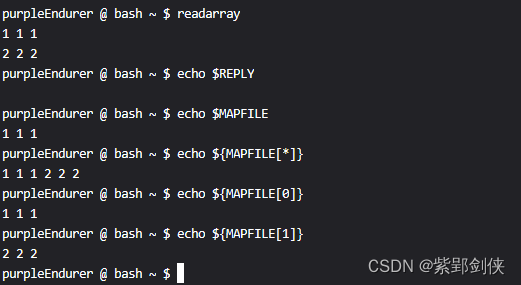
我们输入了1 1 1和2 2 2两行数据后,按Ctrl+D结束输入。
对于read命令,如果不指定用来存储数据的变量名,数据将保存在变量REPLY中。
但对于readarray命令,如果不指定用来存储数据的数组变量名,数据将保存到存储到MAPFILE数组中。
2.2 从标准输入读取数据并存储到指定的数组
?例2.2?从标准输入读取两行数据并存储到指定的数组变量a
purpleEndurer @ bash ~ $ readarray a
1 2 3
4 5 6
purpleEndurer @ bash ~ $ echo $a
1 2 3
purpleEndurer @ bash ~ $ echo ${a[*]}
1 2 3 4 5 6
purpleEndurer @ bash ~ $ echo ${a[0][*]}
1 2 3purpleEndurer @ bash ~ $ echo ${a[1][*]}
4 5 6
purpleEndurer @ bash ~ $?

我们输入了 1 2 3和4 5 6两行数据,可以看到数据存储到数组变量a中。
系统默认从数组下标0开始存储,所以命令执行的结果如下:
a[0][0]=1??a[0][1]=2??a[0][2]=3
a[1][0]=4? a[1][1]=5? a[1][2]=6
2.3?使用 -O?选项指定起始下标
例 2.3.1?在例2.2的基础上,我们继续从标准输入读取两行数据并存储到指定的数组a,起始下标为1
purpleEndurer @ bash ~ $ readarray -O1 a
a b c
d e f
purpleEndurer @ bash ~ $ echo ${a[*]}
1 2 3 a b c d e f
purpleEndurer @ bash ~ $ echo ${a[1][*]}
a b c
purpleEndurer @ bash ~ $ echo ${a[2][*]}
d e f
purpleEndurer @ bash ~ $???
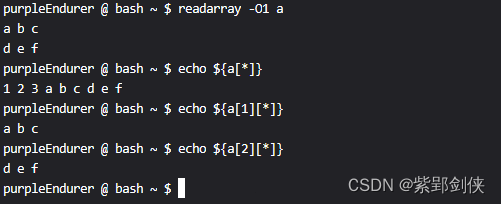
我们输入了a b c和d e f 两行数据。由于我们指定从下标1开始,
所以二维数组a的第一行数据没有变化
二维数组a的第二行数据变成 [a b c]
[d e f]则变成了二维数组a的第三行的数据。
这时的二维数组a的值为:
a[0][0]=1??a[0][1]=2??a[0][2]=3
a[1][0]=a? a[1][1]=b? a[1][2]=c
a[2][0]=d? a[2][1]=e? a[2][2]=f
可见,对于二维数组来说,-O指定的是起始行数。
那么,对于一维数组呢?-O指定的是什么呢?
我们通过下面的例子来看一下。
例2.3.2?先定义一维数组a并初始化其值为1 2 3,然后用readarray命令读取数据 a b c,并指定从数组a的下标2开始存储。
purpleEndurer @ bash ~ $ a=( 1 2 3)
purpleEndurer @ bash ~ $ echo $a
1
purpleEndurer @ bash ~ $ echo ${a[*]}
1 2 3
purpleEndurer @ bash ~ $ readarray -O2 a
a b cpurpleEndurer @ bash ~ $ echo ${a[*]}
1 2 a b c
purpleEndurer @ bash ~ $?
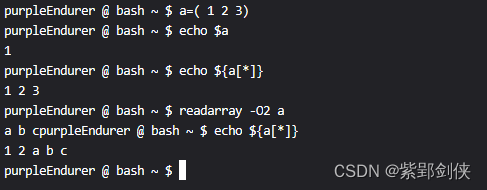
注意:
在输入a b c后要按Ctrl+D两次,这样可以让数组a保持为一维数组。
如果按下了Enter键,数组a将变成二维数组。
可以看到,对于一维数组来说,-O选项指定的是元素的下标。
例2.3.3?不使用-O选项,指定数组名中原有数据会先被清空
purpleEndurer @ bash ~ $ readarray a
1
2
3
4purpleEndurer @ bash ~ $ echo ${a[*]}
1 2 3 4
purpleEndurer @ bash ~ $ readarray a
a
b
purpleEndurer @ bash ~ $ echo ${a[*]}
a b
purpleEndurer @ bash ~ $?
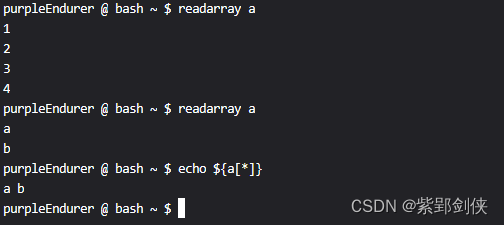
在第一次执行?readarray a?命令时,我们输入的数据1、2、3、4被存储到数据变量a中。
在第二次执行?readarray a?命令时,我们输入的数据a、b被存储到数据变量a中,原来的数据1、2、3、4被清空了。
2.4?用-n指定有效行数
例 2.4?从标准输入读取2行数据,储存到数组变量a。
purpleEndurer @ bash ~ $ echo $a
purpleEndurer @ bash ~ $ readarray -n 2 a
1 1 1
2 2 2
purpleEndurer @ bash ~ $ echo ${a[*]}
1 1 1 2 2 2
purpleEndurer @ bash ~ $ echo ${a[1]}
2 2 2
purpleEndurer @ bash ~ $ echo ${a[0]}
1 1 1
purpleEndurer @ bash ~ $?
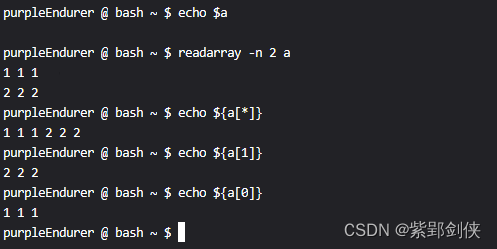
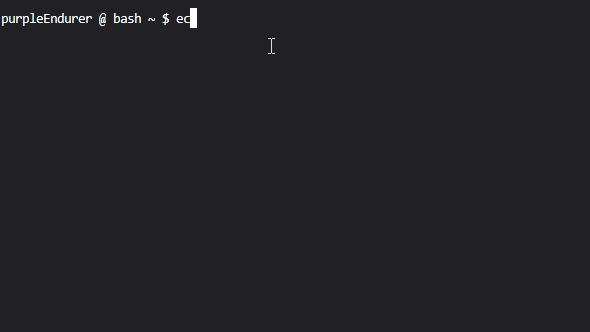
可以看到,我们输入两行数据后,readarray命令就自动停止输入,并将我们输入的数据存储到数组变量a中。
2.5?用-s来路过部分数据
例 2.5?跳过标准输入中的前2行数据,将后续的数据存储到数组变量a中。
purpleEndurer @ bash ~ $ echo $a
purpleEndurer @ bash ~ $ readarray -s 2 a
1 1 1
2 2 2
3 3 3
4 4 4?
purpleEndurer @ bash ~ $ echo ${a[*]}
3 3 3 4 4 4
purpleEndurer @ bash ~ $ echo ${a[1]}
4 4 4
purpleEndurer @ bash ~ $ echo ${a[0]}
3 3 3
purpleEndurer @ bash ~ $?
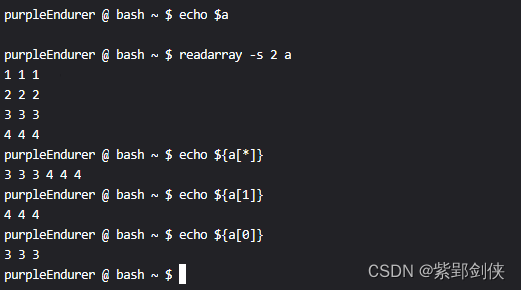
我们输入了1 1 1 、2 2 2、3 3 3、4 4 4四行数据,由于-s 2?选项,前两行数据1 1 1 、2 2 2被跳过,数组变量a存储的数据是3 3 3、4 4 4,即:
a[0][0]=3?a[0][1]=3??a[0][2]=3
a[1][0]=4? a[1][1]=4? a[1][2]=4
2.6?用-c和-C选项使用回调程序
例 2.6?从标准输入读取数据,每读入2行数据就调用echo命令显示字符串---
purpleEndurer @ bash ~ $ readarray -c 2 -C "echo ---"
a
b
--- 1 bc
d
--- 3 de
f
--- 5 fpurpleEndurer @ bash ~ $ echo ${MAPFILE[*]}
a b c d e f
purpleEndurer @ bash ~ $?
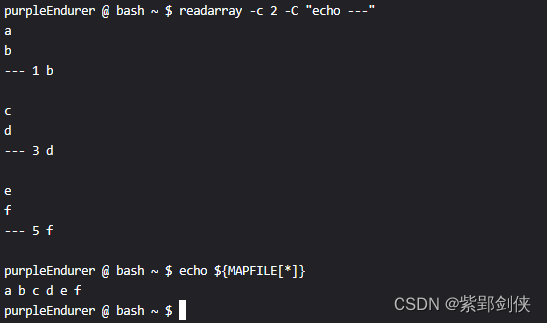
2.7?使用输出重定向和-t选项从磁盘文件中读取数据
例2.7.1?利用seq命令创建数据文件d.txt,然后利用readarray和输入重定向将数据文件d.txt的内容存储到数组变量a
purpleEndurer @ bash ~ $ seq 5 > d.log
purpleEndurer @ bash ~ $ cat d.log
1
2
3
4
5
purpleEndurer @ bash ~ $ readarray a < d.log
purpleEndurer @ bash ~ $ echo ${a[*]}
1 2 3 4 5
purpleEndurer @ bash ~ $ echo ${#a[*]}
5
purpleEndurer @ bash ~ $ echo ${#a[1]}
2
purpleEndurer @ bash ~ $ echo ${#a[1][1]}
2
purpleEndurer @ bash ~ $ echo ${#a[1][2]}
2
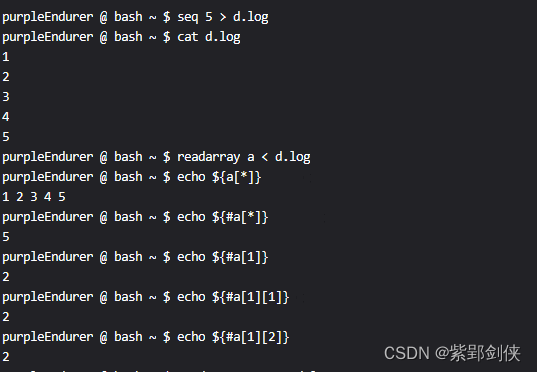
例2.7.2?在使用输入重定向和readarray -t?命令从例2.7.1创建的d.txt文件读取数据存储到数组变量a
purpleEndurer @ bash ~ $ readarray -t a < d.log
purpleEndurer @ bash ~ $ echo ${a[*]}
1 2 3 4 5
purpleEndurer @ bash ~ $ echo ${#a[*]}
5
purpleEndurer @ bash ~ $ echo ${#a[1][1]}
1
purpleEndurer @ bash ~ $ echo ${#a[1][2]}
1purpleEndurer @ bash ~ $ echo ${#a[1]}
1
purpleEndurer @ bash ~ $?
从 echo ${a[*]}? 和??echo ${#a[*]}?的命令执行结果来看,readarray a < d.log?和?readarray -t a < d.log?执行的结果似乎是一样的。
但从echo ${#a[1]}、echo ${#a[1][1]}、echo ${#a[1][2]}命令的执行结果看,readarray a < d.log?和?readarray -t a < d.log?执行的结果是不一样的。
这是因为readarray a < d.log?没有过滤换行符。
3 mapfile命令
mapfile命令不仅在功能上和readarray命令相同,而且在命令格式上也和readarray命令相同。
但是mapfile命令的帮助信息比readarray命令要详细得多。
purpleEndurer @ bash ~ $ help mapfile
mapfile: mapfile [-n count] [-O origin] [-s count] [-t] [-u fd] [-C callback] [-c quantum] [array]
? ? Read lines from the standard input into an indexed array variable.
? ??
? ? Read lines from the standard input into the indexed array variable ARRAY, or
? ? from file descriptor FD if the -u option is supplied. ?The variable MAPFILE
? ? is the default ARRAY.
? ??
? ? Options:
? ? ? -n count ?Copy at most COUNT lines. ?If COUNT is 0, all lines are copied.
? ? ? -O origin Begin assigning to ARRAY at index ORIGIN. ?The default index is 0.
? ? ? -s count ?Discard the first COUNT lines read.
? ? ? -t ? ? ? ? ? ? ? ?Remove a trailing newline from each line read.
? ? ? -u fd ? ? ? ? ? ? Read lines from file descriptor FD instead of the standard input.
? ? ? -C callback ? ? ? Evaluate CALLBACK each time QUANTUM lines are read.
? ? ? -c quantum ? ? ? ?Specify the number of lines read between each call to CALLBACK.
? ??
? ? Arguments:
? ? ? ARRAY ? ? ? ? ? ? Array variable name to use for file data.
? ??
? ? If -C is supplied without -c, the default quantum is 5000. ?When
? ? CALLBACK is evaluated, it is supplied the index of the next array
? ? element to be assigned and the line to be assigned to that element
? ? as additional arguments.
? ??
? ? If not supplied with an explicit origin, mapfile will clear ARRAY before
? ? assigning to it.
? ??
? ? Exit Status:
? ? Returns success unless an invalid option is given or ARRAY is readonly or
? ? not an indexed array.
purpleEndurer @ bash ~ $?

本文来自互联网用户投稿,该文观点仅代表作者本人,不代表本站立场。本站仅提供信息存储空间服务,不拥有所有权,不承担相关法律责任。 如若内容造成侵权/违法违规/事实不符,请联系我的编程经验分享网邮箱:chenni525@qq.com进行投诉反馈,一经查实,立即删除!
- Python教程
- 深入理解 MySQL 中的 HAVING 关键字和聚合函数
- Qt之QChar编码(1)
- MyBatis入门基础篇
- 用Python脚本实现FFmpeg批量转换
- 十、Three场景实现多个物体的合并
- 【改进YOLOv8】电动车电梯入户检测系统:融合HGNetv2改进改进YOLOv8
- 位运算符和移位运算符
- 链接全球数十亿台设备!物联网行业如何应对数据管理、实时分析和供应链优化的挑战?
- 成人高考和自考到底应该选哪个呢?
- 功率放大器应用领域指南(功率放大器应用场景介绍)
- JAVA------基础篇
- 一键汉字转拼音的方法,在线拼音转换,教你一键搞定
- 11 STM32标准库函数 之 备份寄存器(BKP)所有函数的介绍及使用
- 聚焦老年生活与健康,“老有所依·情暖夕阳”元岗街社区微型养老博览会顺利开展